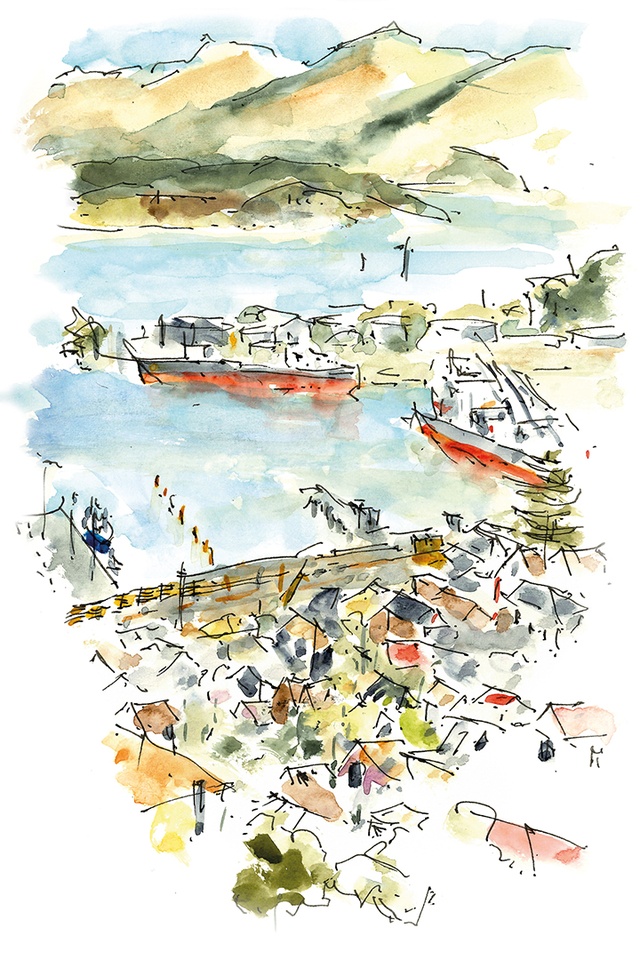A pleasant morning in Lyttelton
Pip Cheshire considers Lyttelton a brave little town, chin first into the blustering southerlies, yet alive with life and energy and a palpable sense of history.

I am not a walker. though I enjoy the idea of moving one limb after another and, thereby, moving through the world, the reality is a bit more laboured. And so it is that I find myself stationary, warm and comfortably ensconced in an armchair while others in the house are heading down the streets below my eyrie under a cool grey and threatening sky.
I am near the farthest reaches of housing on the east side of the bowl that is Lyttelton. Below, around and above is a microcosm of our age laid out: a diorama animated with the coming and going of 21st-century life. It is such a big view, and so filled with the artefacts of our occupation, that things are compressed into a textural overlay, as if a rich and densely woven mantle had been pulled over the roll of the land. That built coverlet reveals much of our recent occupation of the land.
On the lower slopes around the water’s edge, an apron of reclamation and a couple of wharves reach out to host the few ships that defy the imperative of containerisation. The deep-sea behemoths, top heavy with rust-streaked containers, tie up on a wharf lost to my view by the curve of the hills, but a dull, metallic clanking from the restless straddle cranes makes its presence known. Beyond the alienated edge of the working port, a thicket of cottages climbs up the slopes, passing the commercial strip strung out along a coastal escarpment. This is a village built on a history of trade and immigration, marked now by a few solid buildings that withstood the brutal shaking of 2011, whose epicentre was mere metres away. These few surviving buildings display the optimism of a new and establishing colony, their entablatures bearing names of shipping companies and government agencies. Their interiors no longer harbour clerks rubber-stamping and filing in triplicate, but are kitted out as cafés and bars with the post-hippie insouciance that colours the town and gives it such charm.
Further up the wide, straight streets that fan out from the water’s edge, the steepening terrain defeats the surveyor’s theodolite and the macadam veers off in a series of switchbacks accessing a patchwork of properties perched on the highpoints, and in the valleys and gulleys of the rolling landscape. It is as a transect, that tool beloved of the new urbanists, a section through the landscape, analysed and notated. If we imagine a sectional cut from water’s edge to the empty slopes above the town, we would see a landform of escalating steepness as we move from port apron to the unoccupied commons above. We would see vegetation progressing from ordered garden plots squeezed between tightly packed cottages on the lower slopes to grassland, trees and bush high above the town. James McNeish, recounting the sheep rustler Mackenzie’s escape from the town’s gaol, beautifully describes the view from high on the rocky craigs as searching gaolers far below, and appearing no bigger than dogs, beat their way up bush-filled valleys below.
We find a similar progression in the buildings, devolving from the remnants of the port’s pre-container heyday that hint still at the days when the town had a large working population of wharfies, railway workers and the visiting crews from cargo ships, and many watering holes to sustain them. The east-westaligned main street of verandahed shops and cafés offers shelter from the southerlies blowing across the harbour from Gebbies Pass and gives onto clapboard cottages marching cheek by jowl up the gridded lower slopes to a ring of morecontemporary housing scattered haphazardly across the higher, steeper slopes.
Where the progression of houses is a mute reflection of the way we occupy the land, movement glimpsed from my vantage point invites a more contemporary reading. The movements are small and not immediately noticeable against the dense compilation of forms and colours of the buildings and attendant gardens. At first, it is random movement that catches the eye: the whirling of gulls above the town. They were not where I expected, but rising and falling in the draughts above the houses, inland. I wondered if this was evidence of change. As a nipper, I would come over to the port where always it seemed the air was alive with a screeching flock diving to the rear of small, port-based trawlers. Has the fishing quota system and the appearance of large sea-going trawlers led to the demise of those hard-working little vessels with their optimistic names?
Below the birds, building tape on the roof of an arrested house alteration flutters nervously and, a block or two over, a tino rangatiratanga flag moving around a pole in the swirl of valley-confused gusts catches the eye. Beyond that, the slow movement along the reclaimed platform of the waterside apron comes into focus. The hard stand is incised by railway tracks, along which wagon loads of logs and coal are dragged from the hinterland beyond the encircling remnants of the volcanic cone that shaped the harbour. It is a carefully orchestrated arrangement that conjures up Adam Smith’s ‘invisible hand’: coal and log trains passing container-laden wagons headed the other way, each a manifestation of aggregated consumer activity. Smith posited that the accumulation of individual selfinterest would inevitably lead to a self-regulating economy and that the ensuing activity would benefit society as a whole.
This is an economic theory that continues to be as close to a guiding philosophy as our current government and its right-wing minority partner ever gets. Gazing down on the wagon loads of Te Waipounamu’s extracted resources heading offshore with bugger-all processing or created value, I am certain that the ‘invisible hand’ and an unfettered market is neither selfregulating nor up to the business of sorting out some of the more complex conundrums that beset our little country. The pervasive hold of such economic dogma within the political realm is a rude frustration hindering our ability to address the currently entrenched social issues of inadequate housing, a battered health system and the cruel inequities of child poverty.
I wondered what it would be like were the village below me to support more employment than that offered by the loading of unprocessed natural resources. Would there be studios alongside the marine workshops, humming with laser cutters, lathes and looms transforming the products of the plains just over the hills into goods to be shipped out? I know too well the ruthless economies of small-scale manufacturing in a global economy and have my doubts that the simple transformation of raw resources will be enough on its own to provide the dough we need. Perhaps the success of Marlon Williams, Aldous Harding, Delaney Davidson, the late Bill Hammond and the other creative souls who have made the town their base suggests creative activity may be a more productive path. Were that to be so, the scattering of cheap houses and quake-damaged buildings within the bay around me may continue to provide, as they have for so many in the past, all the building that’s necessary.










